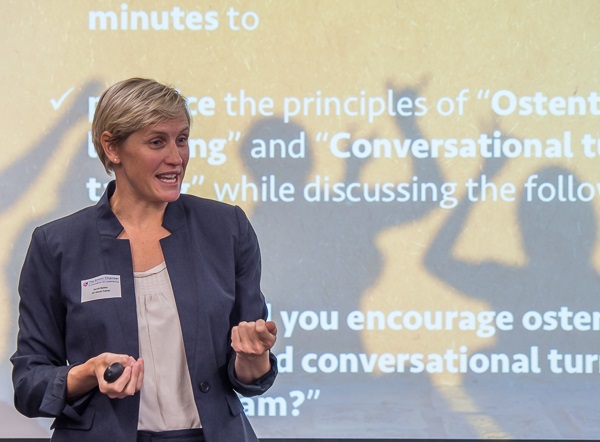
On Wednesday 20 September 2017, the British Chamber of Commerce (BCC) in Luxembourg conducted the 3rd workshop in its “Art & Science of Communication” series at the offices of Badenoch & Clark; the chamber’s People and Leadership workgroup welcomed around fifty participants to learn about the communication secrets of successful teams with Sarah Battey and Claudia Neumeister leading the participants through the interactive session.
Claudia Neumeister opened with two questions to the group – What were the characteristics of the most successful team they have experienced to date and, most importantly, how did they feel on that team? The themes of respect, trust, transparency and, of course, communication were noted. Participants agreed that they felt valued, more motivated and more confident when part of a team with these characteristics.
Sarah Battey shared insights from Google’s research on team effectiveness (see the whole study here: http://bit.ly/2fJEqyF). In researching the key to success in teams in their organisation, Google discovered that the most successful teams shared one trait in particular: team members felt psychologically safe. Other factors identified were dependability of team members, structure and clarity, meaning and impact of role and team – but psychological safety was by far the most important.
“Feeling psychologically safe in a team means that individuals will ask more questions, dare to challenge and come up with new and perhaps unusual ideas without the fear of being negatively judged” explained Sarah Battey.
What can leaders do to create more psychological safety on their teams? The key to psychological safety lies in the style of communication. Successful teams ensure that everyone on the team is included, heard and respected. Giving everyone the opportunity to speak without interruptions, and inviting team members to speak in equal measures is one action leaders can take. Another important behaviour leaders can model is “Ostentatious listening” (a term coined by Charles Duhigg in his book “Smarter, Faster, Better” (2016)) actively engaging by asking questions, summarising what they have heard and by expressing interest via their body language.
The ratio of positive to negative communications on a team is extremely important for fostering psychological safety. Claudia Neumeister explained how researchers have found that successful teams express six positive thoughts for every negative one (in successful marriages, she explained, the ratio is 5:1).
In the final exercise of the session, participants learned how to communicate in an “active-constructive” manner. “Imagine you have just received a long-awaited promotion and have come home to tell your partner” said Sarah Battey. Your partner might respond in one of four ways – interested or disinterested (active or passive) and positively or negatively (constructive or destructive).
An active-constructive style of communication in which your partner recognises your achievement and responds with interest increases your psychological well-being and confidence. In teams, an active-constructive communication style can have a direct impact on an individual’s success.
During the workshop, participants then had the opportunity to practice their ostentatious listening and active-constructive communication skills.
To close the session, participants were encouraged to consider one small step they could take to increase psychological safety on their teams.
One participant remarked: “we often attend international conferences for these topics... really nice to have quality input right on the doorstep”
Join the BCC people and leadership group for their final workshop in the series “The Art & Science of Communication” on 6 December at 08:30 in the offices of Badenoch & Clark. The group will be exploring communication in organisations and how it builds culture.








